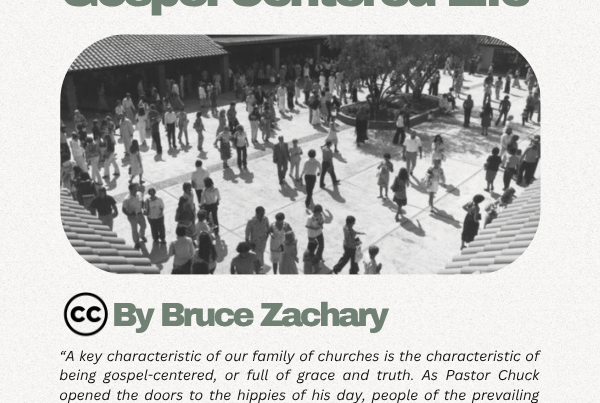
And his spear was in his hand… (1 Sam. 19:9; 20:33; 22:6)
Oftentimes in media, whether in film, television, music, or literature, a motif is woven throughout a story. Motif is the repetition of a concept, action, object, or other distinctive marker which carries some symbolic meaning. Out of the countless examples of motif, I think of “the girl in the red coat” who is featured in the World War II film Schindler’s List (1993). Twice in this black-and-white film, color is introduced through the red coat of a young Jewish girl, drawing our attention to this peripheral figure. Through the use of color in the midst of a sea of black and white, the red-coated girl becomes a repeated motif, inviting the audience to mull over the significance of this girl within the larger movie.
In a similar way, literary motif is one way the Holy Spirit communicates through the inspired authors of Scripture. Saul’s spear (Heb: ḥănît) is his weapon of choice, particularly in his pursuit and attempted murder of David. There are a total of five scenes featuring the spear, culminating in David’s surprising victory over Saul. In this short study, we will observe the development of the spear motif. First, we will take note of four scenes where Saul attacks another with his spear; second, we will consider David’s surprising victory over Saul; third, we will reflect on how this motif presents us with a picture both of Jesus’ victory over the spiritual rulers and his treatment of human enemies.
Saul’s Attacks
The first scene which features Saul’s spear takes place in the royal house. After David had been anointed by Samuel, the Spirit of God departed from Saul and was replaced by a distressing spirit. When Saul became distressed, it was David’s job to sooth him by playing the harp. However, this was problematized by Saul’s growing jealousy over both David’s military success and general popularity (c.f., 1 Sam. 18:6-9).
Following this, we are given the ominous report that, “While David was daily playing the harp which was in his hand, the spear was in Saul’s hand” (1 Sam. 18:10). The report of these contrasting hands set up a comparison between the peaceful presence of David, attempting to sooth the king with his harp, and the murderous tendencies of Saul with his weapon of choice. No sooner is Saul’s spear introduced into the story before Saul “hurled the spear, for he thought, ‘I will strike David against the wall,’” in his first attempted murder (1 Sam. 18:11).
Escaping this initial attack, David carried on in Saul’s service. After a series of episodes including David’s marriage to Saul’s daughter, Michal, David found himself once again playing the harp for the distressed king with “his spear (ḥănît) in his hand” (1 Sam. 19:9). In this second scene, “Saul attempted to strike David against the wall with his spear, but David eluded Saul while the spear struck the wall. Then David escaped and slipped away in that night” (1 Sam. 19:10).
At this point in the story, Saul’s spear is the tool he uses to try and destroy his competition. Though his competition is an innocent man, Saul does not hesitate to pursue death in order to rid himself of what he perceives as a threat to his throne. His spear, then, can be perceived as a symbol of Saul’s tendency to take up violent means to accomplish his goals and defeat his enemies.
The third scene featuring Saul’s spear resembles the first two, but with a twist. After two attempted murders, David kept his distance from his father-in-law. Jonathan, Saul’s son and David’s friend, attempted to mediate peace between the two. However, while Jonathan questioned the justice of his father’s actions, Saul’s rage stirred: “Then Saul hurled the spear at [Jonathan] to strike him. Therefore Jonathan knew that his father was determined to kill David” (1 Sam. 20:33).
In a moment of rage, Saul’s violent tendencies extended from his hatred for David to his own son. We see that Saul’s violence is not isolated to David, but, in what can only be described as an uncontrollable fit, it threatens anyone who stands in his way.
The final scene where Saul is shown wielding his spear is unique in a couple ways. After David fled the royal house, he came to the tabernacle where Abimelech, the high priest, resided. He asked Abimelech for aid in his flight and, after their exchange, he was sent away with food and a sword (1 Sam. 21:1-9). Unfortunately for Abimelech, one of Saul’s servants, a man named Doeg, was at the Tabernacle. Doeg reported this event to Saul which led to the eventual genocide of Abimelech’s family.
The moment of this discovery opens with this description: “Saul heard that David was discovered, and his men were with him. Now Saul was sitting in Gibeah under a tamarisk tree in a high place, and his spear was in his hand, and all his servants were stationed around him” (1 Sam 22:6). The phrase “his spear was in his hand” is identical to the phrase preceding Saul’s second attempt at David’s life (c.f., 1 Sam. 19:8). At this point, with the motif of Saul’s spear firmly established, we should expect some violent outburst on the part of Saul.
The twist in this scene is twofold. First, Saul escalates his violence. When Jonathan sought to help David, Saul attacked Jonathan. However, when Abimelech helped David, he not only sought the life of Abimelech but his entire family (1 Sam. 22:16). Second, whereas in previous scenes Saul took matters into his own hands, now Saul draws more people into his orbit of violence. Initially he commanded his guard to annihilate the priestly family (1 Sam. 22:17); then, after their refusal, Doeg agrees to carry out this murderous order (1 Sam. 22:18).
The Disarming of Saul
We see in these four scenes the way that Saul relates to his enemies. Now, in a final scene, we see exactly how David achieves victory over his homicidal pursuer. 1 Samuel 26 recounts the final encounter between Saul and David, as well as the final occurrence of the spear motif in Samuel. In fact, the word “spear” (ḥănît) occurs no less than six times in this story (1 Sam. 26:7, 8, 11, 12, 16, 22) indicating a climactic completion for this narrative thread.
The scene opens with Saul and his men camped nearby David. In the dead of night, David and Abishai, one of his commanders, snuck into Saul’s camp while he was sleeping. There they found Saul asleep “with his spear (ḥănît) stuck in the ground near his head” (1 Sam. 26:7). Abishai petitioned David to let him take Saul’s spear and strike him, but David refused. Instead, “David took the spear (ḥănît) and jar of water which was by Saul’s head, and they went their way” (1 Sam. 26:12).
After both disarming Saul of his spear and fleeing a safe distance, David called out with a loud voice to wake up Saul’s camp. Seeing that David spared his life, Saul proclaimed that he had “sinned” and acted “foolishly.” Responding to this “David answered and said, ‘Behold! The spear (ḥănît) of the king! Let one of your servants pass over and take it. And may the LORD reward every man for his righteousness and his faithfulness, since the LORD gave you into my hand today, yet I was not willing to stretch out my hand against the LORD’s anointed’” (1 Sam. 26:22-23).
In this scene, we see both the righteousness and victory of David on display precisely through his refusal to take up the spear, the symbol of conquest through one’s own violence. David never again saw Saul, and Saul, who lived by the sword (and spear), died by the sword.
Jesus Disarms the “Rulers”
The spear motif woven through these narratives present us with a vivid picture both of Jesus’ treatment of enemies and his victory over the spiritual powers. Jesus’ ethic regarding the treatment of one’s enemies was revolutionary: “Love your enemies, do good to those who hate you” (Luke 6:27, ESV; c.f., Matt. 5:44). Paul picked up on this when writing to the Romans saying, “Never avenge yourself, but leave it to the wrath of God, for it is written, ‘Vengeance is mine, I will repay, says the Lord’” (Rom. 12:19, ESV; c.f., Deut. 32:35). By refusing to take up the power of the spear, David foreshadowed the ethic of Jesus. He refused to avenge himself, but trusted God to do justice with his enemy.
Additionally, like David, Jesus eluded death many times (e.g., John 7:1; 8:59; 10:31). However, recognizing that his enemy was spiritual rather than flesh and blood, Jesus gave himself up to the violence of his pursuers. By doing this, Jesus “disarmed the [spiritual] rulers and authorities and put them to open shame, by triumphing over them in him” (Col. 2:15; ESV). And what weapon were they disarmed of? The power of death!
Rather than using violence, Jesus became the object of violence by letting death do its worst to him on the cross. The powers used up their arsenal. Then, through his resurrection, Jesus rendered death powerless, disarming the rulers of their most lethal weapon. And now, because the powers have been disarmed, we can take up the song of the redeemed saying, “O death, where is your victory? O death, where is your sting?” (1 Cor. 15:55, ESV; c.f., Hos. 13:14).
Like Christ, we do not need to take hold of victory through violence. We have no need of the spear. Our victory is secure in the one who disarmed death. Now we too, as followers of Jesus, can follow his example of enemy-love: never avenging ourselves, refusing to take up the spear, and trusting God to do justice when we are wronged.










